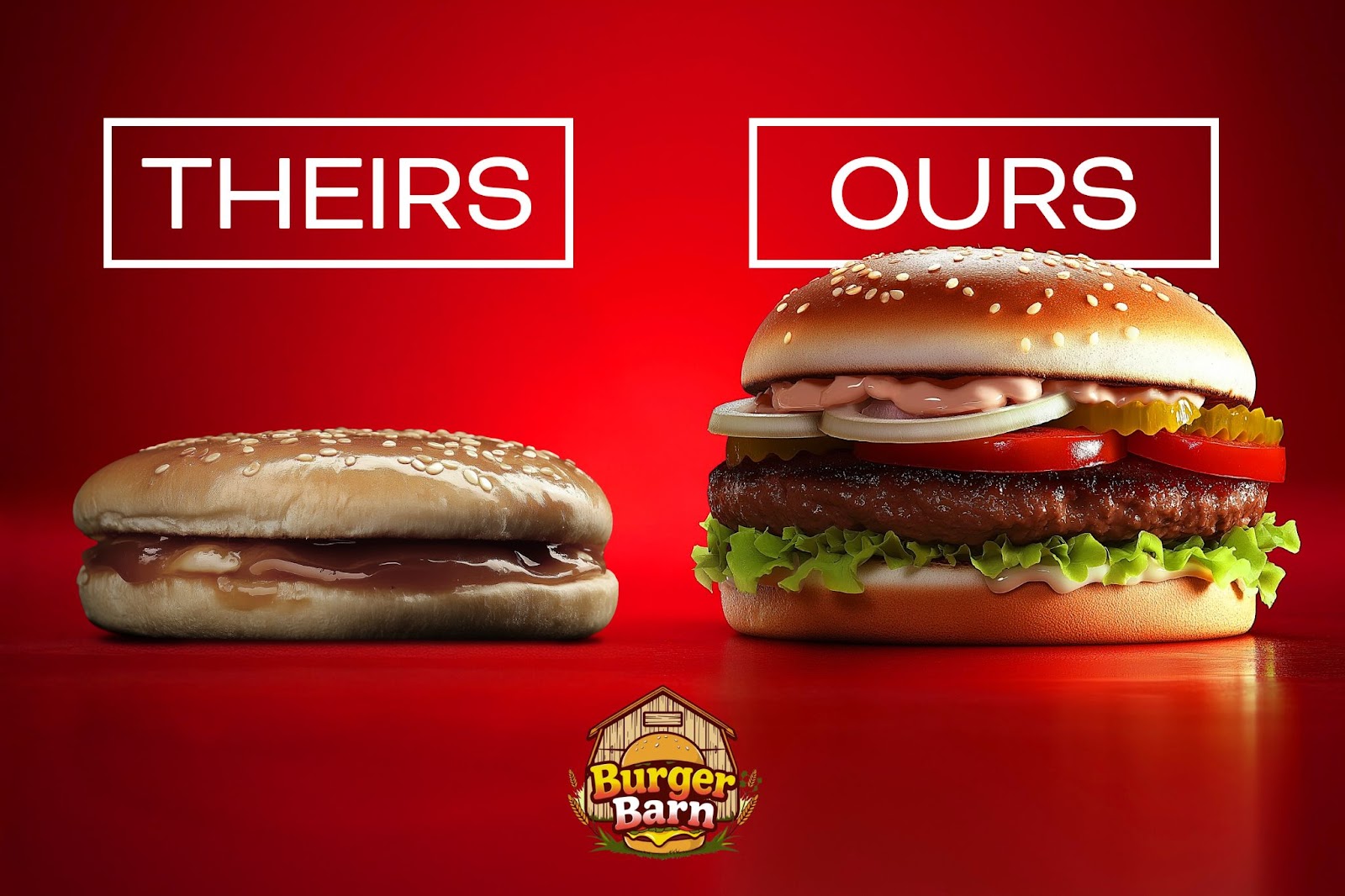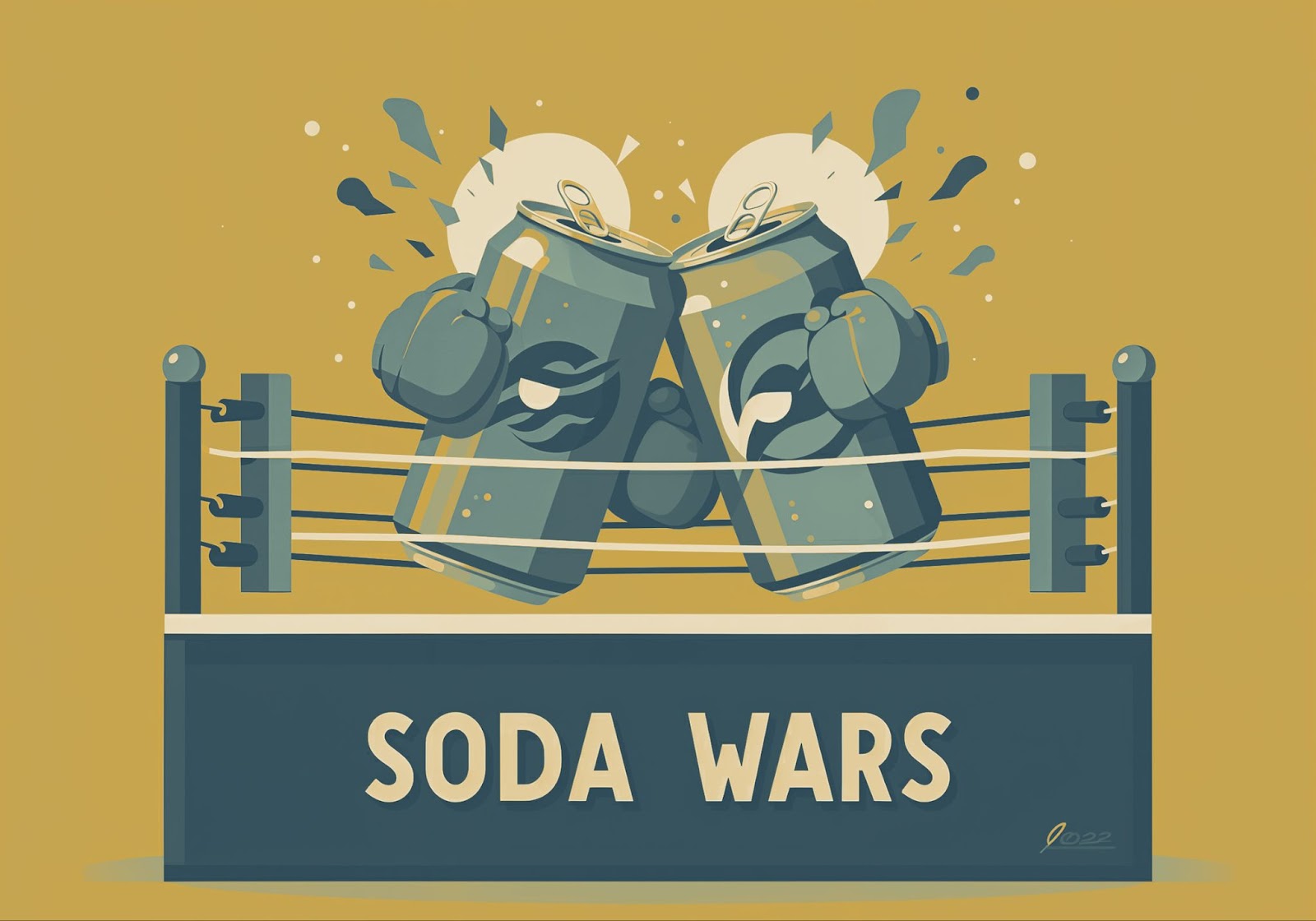For marketing teams comparative advertising, it's a tightrope walk. How do you just highlight advantages over competitors, but avoid statements that could be deemed misleading or false? (and those are violations that can mean fines up to $50,120 per instance, with each consumer exposed counting separately.) Yet, when you get comparative advertising right, those tend to improve consumer attention, recall, and even favorable brand attitudes compared to non-comparative ones.
We wrote this guide to help go through this minefield. Read on and you'll understand how the FTC guidelines regulate comparative advertising: what's permitted, what's forbidden, and how to create hard-hitting but compliant campaigns. All without ending up in legal hot water.
What is Comparative Advertising?

Comparative advertising happens when your brand directly contrasts its product to a competitor's. The 2023 legal definition describes it as advertising that "identifies two or more distinct brands by name, picture or another distinctive characteristic and evaluates the brands' objective features, such as ingredients, style or price, against each other".
U.S. advertisers have embraced this approach across many sectors – from wireless carriers to consumer products. The FTC actually encourages truthful comparative advertising as a way to inform consumers and promote healthy competition.
These ads are pretty common in competitive markets. Industry data shows that roughly one-third of advertising disputes in 2023 involved comparative "superiority or disparagement" claims. Even traditionally cautious sectors like cosmetics have increasingly used comparative ads and resolved related disputes through self-regulation.
In short, comparative advertising is a common tactic – legal in the U.S. as long as it's truthful – that allows brands to boldly pit their products against the competition.
Examples of Comparative Advertising in Practice
Recent years have provided many eye-catching examples of comparative advertising in action:
- Charter vs. T-Mobile (2024): In a Super Bowl 2024 spot, Charter Communications humorously mocked the speed and reliability of T-Mobile's home internet service. The 30-second "Holes" ad showed a frustrated father literally punching a hole through a wall to get a better signal – a tongue-in-cheek jab at T-Mobile's Wi-Fi quality. By highlighting the rival's "purported shortcomings," Charter's comparative ad put its own Spectrum broadband in a favorable light as the better, more reliable choice.
- Samsung vs. Apple (2024): After Apple released a controversial iPad Pro ad called "Crush!" – which depicted art tools being smashed by a press to tout the iPad's capabilities – Samsung saw an opening. Within days, Samsung's mobile division rolled out a retaliatory video titled "Creativity Cannot Be Crushed" that directly riffs on Apple's misstep. The Samsung ad shows a musician salvaging a guitar from wreckage (a scene evoking Apple's ad) and proclaims #UnCrush creativity, implicitly crediting the Galaxy Tab S9 for supporting artists. This real-time comparative response earned buzz by capitalizing on Apple's rare marketing flop.
Benefits of Using Comparative Advertising

Marketers often turn to comparative ads because they work. Research studies consistently find that comparative advertising can outperform non-comparative ads on key metrics. For instance, a recent analysis noted that comparative ads tend to generate higher consumer attention, interest, information recall, and even more favorable brand attitudes than ads that don't mention competitors.
Comparative claims can also boost purchase intent when executed well. In one set of experiments on "green" products, researchers found that comparative messages (e.g., an eco-friendly product vs. a conventional rival) significantly increased consumers' intent to buy the greener option, as long as the comparison highlighted meaningful advantages.
From a brand awareness standpoint, comparative campaigns often grab headlines and social media buzz. And even smaller challenger brands can benefit by comparing themselves to market leaders, effectively borrowing the leader's brand recognition to make their own profile seem more important.
Overall, when truthful and relevant, comparative advertising can educate consumers, sharpen a brand's value proposition, and drive sales by convincing customers to switch from a competitor.
How Does the FTC Regulate Comparative Advertising?

The Federal Trade Commission regulates all advertising – including comparative ads – under a simple mandate: ads must be truthful and non-deceptive. The FTC Act prohibits unfair or deceptive marketing, which means "claims in advertisements must be truthful, cannot be deceptive or unfair, and must be evidence-based."
In practice, this means a company that compares its product to a competitor's must have solid proof for any explicit or implied superiority claims. Honesty and clarity are paramount. The FTC's longstanding policy actually encourages comparative advertising as beneficial for consumers, so long as the comparisons are presented clearly and backed by facts.
Advertisers should identify the basis of comparison (price, performance, etc.) and include disclosures if needed to avoid misleading consumers. For example, if a detergent ad claims "brand X cleans 50% better than the leading competitor," the advertiser should have competent scientific evidence (like head-to-head tests) supporting that 50% improvement. Vague or unsubstantiated boasts risk crossing into deception.
FTC enforcement: The FTC actively enforces these truth-in-advertising standards. If a comparative ad is false or deceptive, the FTC can investigate and take action – which may result in cease-and-desist orders, civil penalties, or other remedies. In 2023, the agency put hundreds of companies on notice about potential penalties for bogus claims.
Notably, the FTC reminded marketers that it can seek civil penalties of up to $50,120 per violation, which "can add up very quickly" – for example, "if 10 consumers see a deceptive ad, that's 10 violations." This means a false comparative claim seen by millions could yield a crippling fine in theory.
While the FTC's powers to obtain consumer redress were curtailed by a 2021 Supreme Court decision, it has revived use of the Penalty Offense Authority to deter deceptive ads. Under this approach, in April 2023 the FTC sent warning letters to around 670 advertisers (from Coca-Cola to Walmart) involved in health product marketing, cautioning that future false claims could trigger hefty fines.
In short, the FTC requires comparative advertising to be truthful, adequately substantiated, and fair – otherwise advertisers may find themselves in legal hot water.
What is the Lanham Act and Its Impact on Comparative Advertising?

Beyond FTC oversight, companies also have a private right of action to police competitors' ads under U.S. law – this is where the Lanham Act comes in. The Lanham Act (specifically, Section 43(a)) is a federal law that, among other things, prohibits false advertising. It allows a business to sue a competitor in civil court for false or misleading claims made in ads.
In fact, as the FTC itself notes, "the Lanham Act gives companies the right to sue their competitors for making deceptive claims in ads." This is a key mechanism through which comparative advertising is regulated: if Company A runs a comparative ad that unfairly disparages Company B with false assertions, Company B can file a Lanham Act lawsuit seeking damages or an injunction to stop the ads.
Under the Lanham Act, the plaintiff (the company suing) must prove several elements: (1) that the defendant made false or misleading statements about its own or another's product; (2) that the deception is likely to influence consumers' purchasing decisions; and (3) that the false claim has caused or will cause competitive or reputational injury to the plaintiff.
Unlike an FTC action, which is brought by the government, a Lanham Act false advertising suit is a business-vs-business civil case, and remedies can include monetary damages (e.g., compensation for lost sales or harm to goodwill) or injunctive relief (court orders to pull or correct the ads).
The Lanham Act's impact on comparative advertising is significant because it effectively deputizes companies to keep each other honest. Major brands closely watch competitors' ads and aren't afraid to litigate if a comparative claim crosses the line. The mere threat of a Lanham Act suit also encourages advertisers to be cautious and truthful when creating comparative messages, knowing a rival could challenge any overstatement.
What are the Legal Implications of Comparative Advertising?

While comparative advertising can be effective, it carries legal risks that advertisers must manage. The first is the potential for competitor challenges. If a rival company believes your comparative ad is false or unsubstantiated they can bring a Lanham Act lawsuit or initiate a complaint with the National Advertising Division (NAD).
These challenges are not rare – in 2023 about one-third of NAD's case load involved comparative superiority or disparagement claims in advertising. In other words, many comparative ads prompt legal scrutiny, whether through the NAD's self-regulatory process or in court. A company that oversteps (e.g., exaggerates how much better their product is) could quickly find itself entangled in a dispute.
The cost of getting it wrong in comparative advertising can be enormous. Lanham Act litigation is known to be expensive and protracted – a major false advertising case can cost millions in legal fees and take years to resolve. For instance, the recent Monster Energy vs. Bang case demonstrates the stakes: Monster sued the maker of Bang Energy drink over false claims (including implied comparisons about a "super creatine" ingredient), and in late 2022 a jury awarded Monster $271 million in damages.
This verdict — one of the largest ever for false advertising — essentially punished Bang's false comparative hype to send a message to the whole industry. Similarly, a 2022 jury verdict in CareDx v. Natera (competitors in medical testing) hit the defendant with $43 million in damages after finding Natera's comparative claims about its kidney transplant test were misleading.
Even when lawsuits are avoided, a company may still have to pull ads, issue corrections, or endure public backlash if a comparative claim is found dubious. The legal implication is clear: comparative ads must be handled carefully. Advertisers should vet comparative claims with substantiation and legal review beforehand.
All in all, while comparative advertising can yield competitive gains, it also opens the door to legal challenges. The frequency of litigation related to comparative claims (dozens of NAD cases annually, and notable court fights each year) shows that competitors and regulators are ready to act. Educated advertisers treat comparative claims as high-risk assertions that require ironclad proof – doing otherwise can invite lawsuits that are costly both financially and to a brand's reputation.
How to Create a Successful Comparative Advertising Campaign?

Launching a comparative advertising campaign requires not only creative flair but also strategic adherence to best practices to stay effective and legal. Here are some best practices backed by research and guidelines for comparative ads:
- Stick to the Facts and Substantiate Everything: A golden rule is to ensure all comparative claims are truthful and backed by solid evidence. Before the campaign launches, gather objective data (lab tests, consumer surveys, etc.) to support any superiority claims. For example, if you say "#1 in cleaning power" versus a competitor, have test results to prove it. The FTC and NAD both expect advertisers to have a "reasonable basis" for claims before they are made.
- Be Clear, Not Confusing: Successful comparative ads make it crystal clear what is being compared and on what attribute. Identify the competitor by name or depiction, and specify the basis of comparison (price, features, performance). If there are any material differences between products that could affect the comparison, disclose them upfront – for instance, "our test compared the deluxe model of our vacuum to the standard model of Brand X." Transparency will prevent consumers from being misled by an apples-to-oranges comparison.
- Keep it Positive or Humorous: While comparative ads necessarily highlight a rival's flaws, the tone should not be mean-spirited or overly negative, which can alienate viewers. Many of the most effective comparative campaigns use wit or humor to take the sting out of the comparison. In fact, over half of U.S. consumers say they prefer ads that make them laugh or feel entertained. A lighthearted touch can engage the audience and even generate goodwill, as seen in Charter's tongue-in-cheek approach to poking fun at T-Mobile.
- Anticipate Reactions and Be Prepared: When you go comparative, you will get the attention of both consumers and the competitor you named. So be ready. Ensure the claims can withstand scrutiny, because competitors might quickly respond (perhaps with their own counter-ads or a NAD complaint). Your marketing team should monitor public and industry feedback closely. If the comparative ad sparks conversation, engage with it (especially on social media) to amplify your message or clarify points.
Following these best practices – truth and proof, clarity, an appealing tone, and readiness to respond – companies can use comparative advertising effectively. When done right, such campaigns not only grab attention but also build trust, as consumers come to see the brand as confident and transparent enough to measure itself openly against the competition.
What are Some Well-Known Examples of Comparative Advertising?

Comparative advertising has produced some memorable marketing battles and lessons. Let's look at a couple of notable recent examples (and what we can learn from them):
One campaign mentioned previously in this guide, Samsung vs. Apple – "Creativity Cannot Be Crushed" (2024). It has quickly become a textbook example of opportunistic comparative advertising. When Apple's "Crush!" iPad Pro ad fell flat (drawing criticism for "crushing" creative tools), Samsung seized the moment to favorably compare itself to its rival. Samsung's rejoinder ad directly referenced Apple's blunder and positioned the Galaxy Tab as the savior of creativity.
The comparative message was implicit but clear – Samsung styled itself as the anti-Apple, caring about artists where Apple seemingly did not. The gambit paid off: Samsung garnered positive buzz and effectively piggybacked on Apple's much larger marketing machine. Lesson learned: comparative ads can be especially powerful when they exploit a competitor's weakness or mistake. By timing its campaign to Apple's stumble, Samsung not only avoided legal issues (it didn't make any false claims about Apple, just a satirical comparison) but also came across as bold and culturally relevant.
Another previously mentioned by very telling example: Monster Energy vs. Bang Energy – Legal Showdown (2022). On the flip side, some well-known "comparative" advertising examples are cautionary tales. Vital Pharmaceuticals (maker of Bang) aggressively promoted its Bang Energy drink as a superior product, implicitly knocking the competition (including Monster) by touting a proprietary ingredient "Super Creatine." These claims helped Bang surge in the market, but they couldn't withstand scrutiny.
Monster sued Bang's maker for false advertising, alleging that "Super Creatine" was a misleading term and that Bang's marketing overstated its benefits. The case, essentially a dispute over comparative claims about product efficacy, ended with a jury siding with Monster and slapping Bang's maker with a $271 million verdict. This outcome had the industry shaken. The key lesson: if you're going to compare (even indirectly) and claim superiority, you must be absolutely truthful.
Beyond these, there are many other famous comparative rivalries – from the long-running Pepsi vs. Coca-Cola soda wars to perennial telecom ads (Verizon vs. AT&T vs. T-Mobile) where carriers trade coverage maps and speed claims in ads. In each case, the brands that succeeded were those that kept their comparisons grounded in truth and resonated with consumers.
The takeaway for marketers is that comparative advertising is a high-reward but high-risk strategy: it can dramatically boost your brand's profile and differentiate you, but it must be done within the boundaries of truth-in-advertising standards.
Final Thoughts
Comparative advertising remains an influential tactic in the U.S. advertising toolbox. When brands truthfully highlight their advantages over competitors, consumers can benefit from the added information, and brands can reap gains in attention and sales. However, the FTC's vigorous enforcement of truth-in-advertising laws means that the bar for honesty has never been higher. Recent trends suggest this scrutiny will only intensify. Regulators are increasingly proactive (as seen with mass warning notices to advertisers), and large court verdicts in false advertising cases are becoming more common.
Running comparative ad campaigns shouldn't feel like walking through a legal minefield. At Luthor, we understand the pressure marketing teams face: you need to create bold, competitive messaging while staying on the right side of FTC regulations.
Our AI-based compliance review tool automatically scans your marketing assets to identify potential regulatory issues before they become problems. With Luthor, you can:
- Cut review time from days to minutes
- Catch compliance issues before they reach consumers
- Document your due diligence process
- Build a culture of compliance without sacrificing creativity
As we've seen, the cost of getting comparative advertising wrong can run into hundreds of millions. Why take that risk when you can automatically check your marketing assets at scale?
Request a Demo → and see how we can help your marketing team create powerful comparative campaigns with confidence.



.jpeg)
